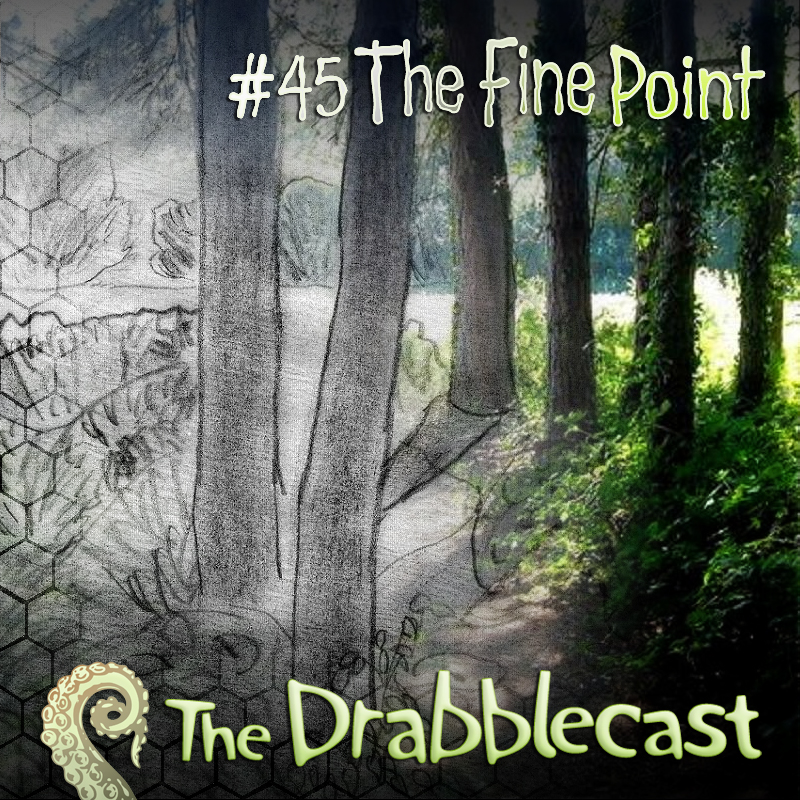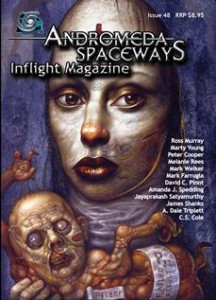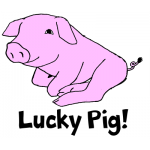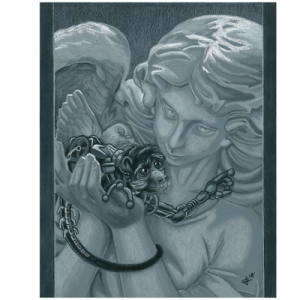written by David Steffen
Introduction
I’ve always felt drawn to creative endeavors of various kinds. When I was a kid, I wanted to be a cartoonist. When I was in high school I wanted to program video games. I tend to wander from one creative medium to another, drawn from one to the next by the prospect of something new and interesting. Writing has been the odd duck in this string of attempts in that I actually have stuck with it for years, and I feel like I’ve gotten to a point where I’m pretty good. I’m not planning to quit any time soon. Yet I’m still always looking to explore other mediums just to keep myself from getting too comfortable, because that way lies boredom. If you believe in Muses, at least in a metaphorical sense, I like to say “My Muse, she be fickle.” I’ve tried to force her to work for me, and that always fails. She just leaves if I try that, and will stay away until I stop trying to give her orders. I am much happier, and much more productive if I just go with the flow, and let her drive the car.
Anyway, the point is that I am now, as ever, having fun trying out new creative fields. At the moment I’m dabbling in story illustrations. I’ve thought about doing something like this for a while. In particular, I think it’d be fun to illustrate my own stories, or the stories of friends.  But I have never felt particularly driven to do so. But then along came the perfect opportunity, as offered by the Drabblecast!
Drabblecast is working their way up to a major site upgrade. As part of this grand project, Bo Kaier, their art director, has kicked off the Drabblecast Art Reclamation Project (follow the link for all the juicy details). Since about episode 130 of their podcast, they’ve had illustrations for every single episode, provided by volunteer artists. When they move to the new site, in an effort to make everything more uniform and to provide shiny new content to attract listeners, Bo has asked for volunteers to fill in the episode artwork for all those older episodes. Anyone who feels they might like to take a crack at it, there are still more than 50 episodes unclaimed–follow the link. The deadline stated there is August 1st, but that’s a very soft deadline. They’re currently shooting for mid-September launch, and anything they don’t have artwork for at that time… will just have to go without art for now. So, I’m sure they’d love to have whoever volunteer.
I decided to volunteer for 3 episode artworks for now, and I’ve completed and submitted by the time of writing this post. These will go up on the Drabblecast site when it’s ready to launch, but I’ve asked for permission to show the artwork I’ve done here. And, for those who might be interested in such things, I will describe how I did each of these pieces of visual art from start to finish.
The Art
“Malish” by Mike Resnick
“Malish” is a story about a deal with the devil. It’s a bit out of the ordinary for that type of story in that the main character is not the one who makes the deal. The main character is Malish, a racehorse, and his owner has made a deal with the devil, described in the story only as “the gnarly little man”. The devil comes to claim the owner, and while he’s there decides to nab the horse as well. But Malish won’t be taken so easily.
1. What to depict?
The first thing I had to decide is what I wanted the illustration to depict. I chose this specific story because I figured that I could do the image of the horse justice with the “pet cartooning” method that I was playing with last year. So, of course, I knew the horse would be in the image. But I wanted to get at least some hint of the speculative element into the image as well. In this case, the only speculative element is the presence of the devil, described as “the gnarly little man”. One of the biggest moments in the story is when the gnarly little man first tries to take Malish in the stable, so I decided to illustrate that.
2. Picture of a horse
Next, I needed to actually get started on the image. In particular, I needed to get the outline of the horse. My method for doing this is perhaps not the most sophisticated, but I think it worked well enough. First I needed a picture of a horse. I mentioned this to Bo and, he is such a nice guy, he contacted another Drabblecast fan and got me a few home pictures of one of her horses. Of the three, one stood out to me as a particularly interesting image, so I picked that. I like it, because the horse is looking right at the camera. You can see the horse’s face very clearly and it is the most prominent part of the image, but you can also see the horse’s body in the background. It has some interesting perspective proportions, with the horses hindquarters appearing smaller than its head.

3. Cartoon outline of the horse
Now I needed the bold line drawing of the horse, to give it a cartoon feel, with digital colors to be added in later. I can draw relatively well in freehand, but I decided that, in order to do the horse image justice, I would do some good old fashioned tracing. I printed out the image, overlaid it with tracing paper, and traced the boldest lines with a nice thick 1.2mm felt pen. The lines on the outer edges were easiest to see, as they showed through the tracing paper most clearly. Some of the others I had to just eyeball. Note, I added some lines that aren’t strictly lines in the photo, to suggest the shape of the horse’s body.
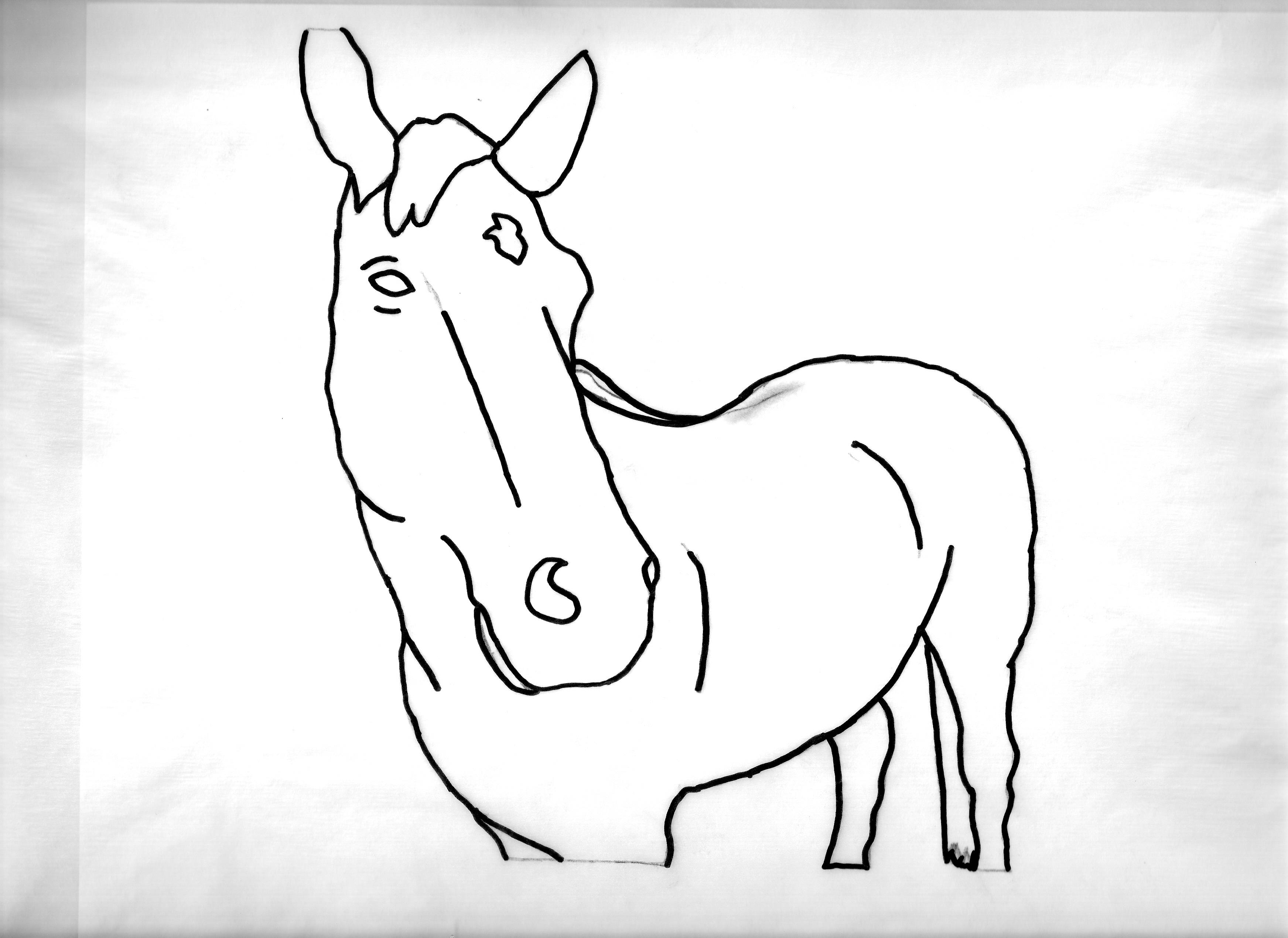
4. Binary image of outline of the horse
One trouble is that, when I scan this nice clean outline, the scanned image that ends up on my computer is not perfectly clean. The scanner picks up some of the paper’s texture, etc… So, to get a really clean image, I opened it up in Microsoft Paint, and saved it as a Monochrome Bitmap. This format only stores white and black, nothing in between, what computer vision folk call “binary thresholding”. Saving it as that leaves some extraneous speckles, but by zooming upsize in Microsoft Paint, I could clean those up with the eraser tool.
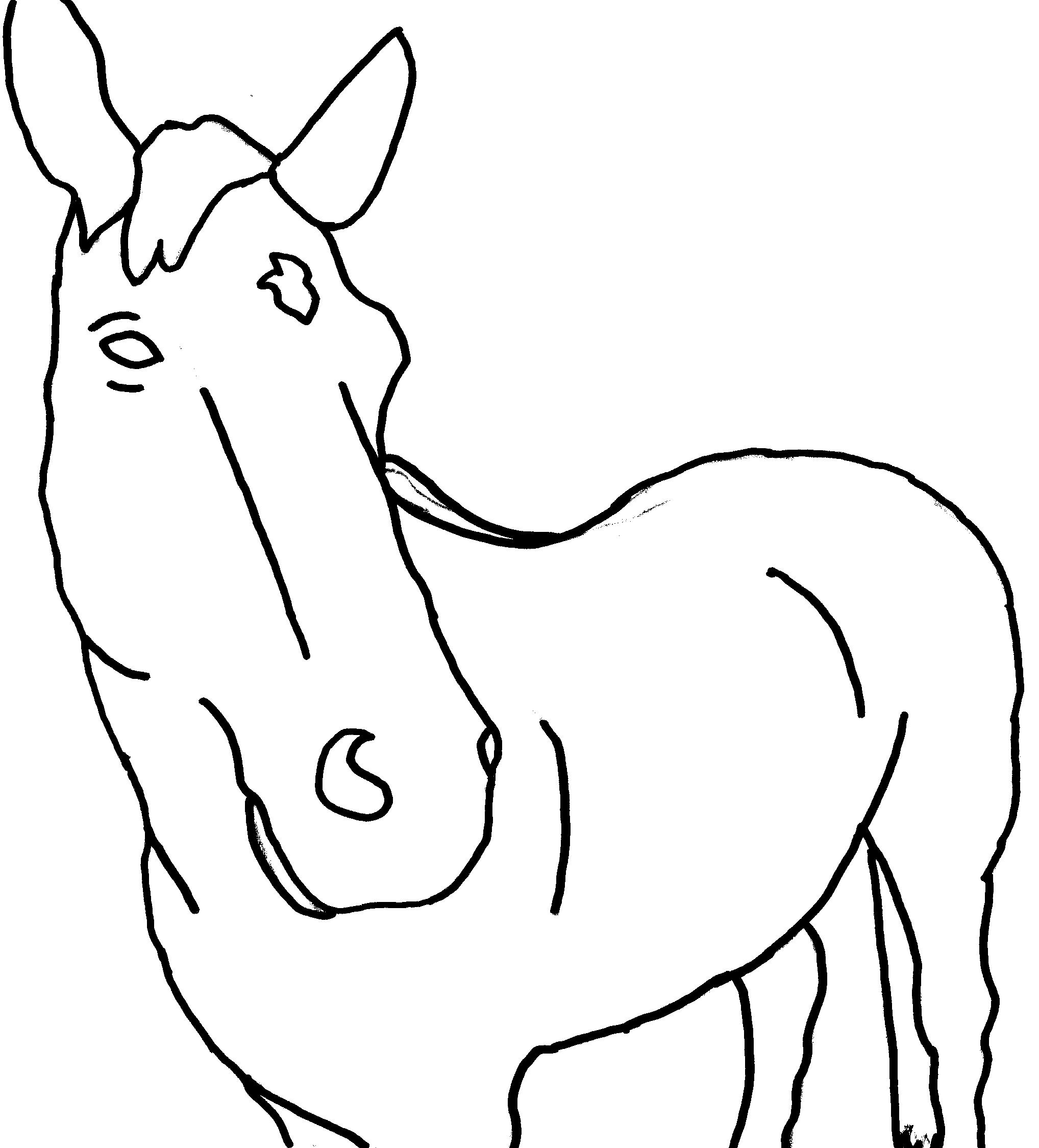
5. Sketching the hand
And then on to the hand. I drew it in a sketchbook freehand using my own left hand as a model. I’m very happy with how the hand turned out, as it’s one of my better attempts at realistic freehand drawing of human anatomy. For now, drawing the hand as close to my hand as I can.

6. Gnarlifying, cartoon outline, binary image
From the sketch I had to get back to a similar type type of cartoon image as the horse. Tracing paper, thick felt tip. And, remember, the hand is supposed to be the hand of the gnarly little man, so at this stage I embellished from the original image to make it gnarly. I tried to add swelling to all of the knuckles, and while I was at it, extend the fingernails and add prominent veins. And then I repeated the same steps I’d used for the horse to get a clean binary image.
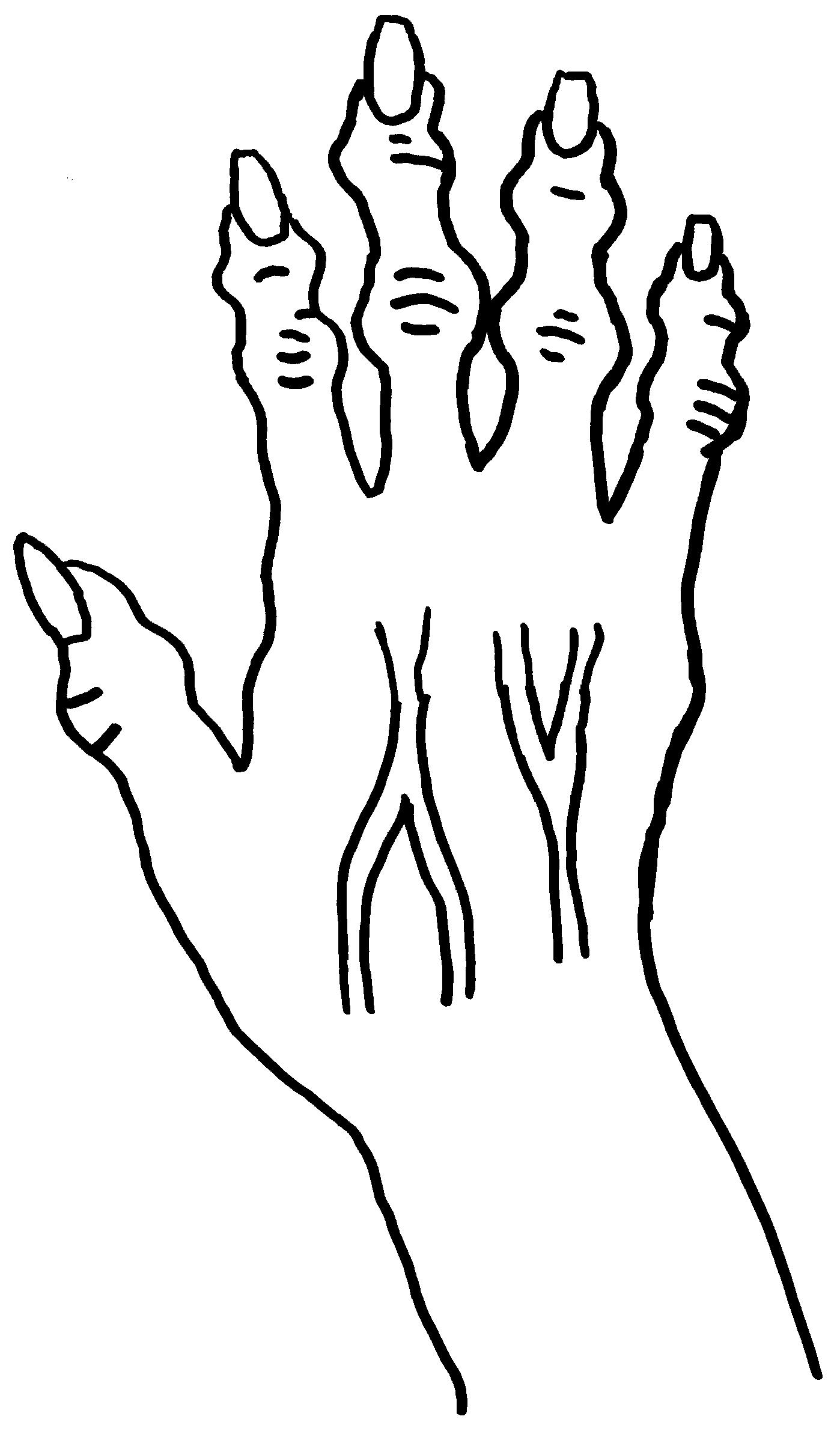
7. Combining cartoon horse with cartoon hand
Now to combine the images, resizing, overlaying. Using Microsoft Paint for this again.
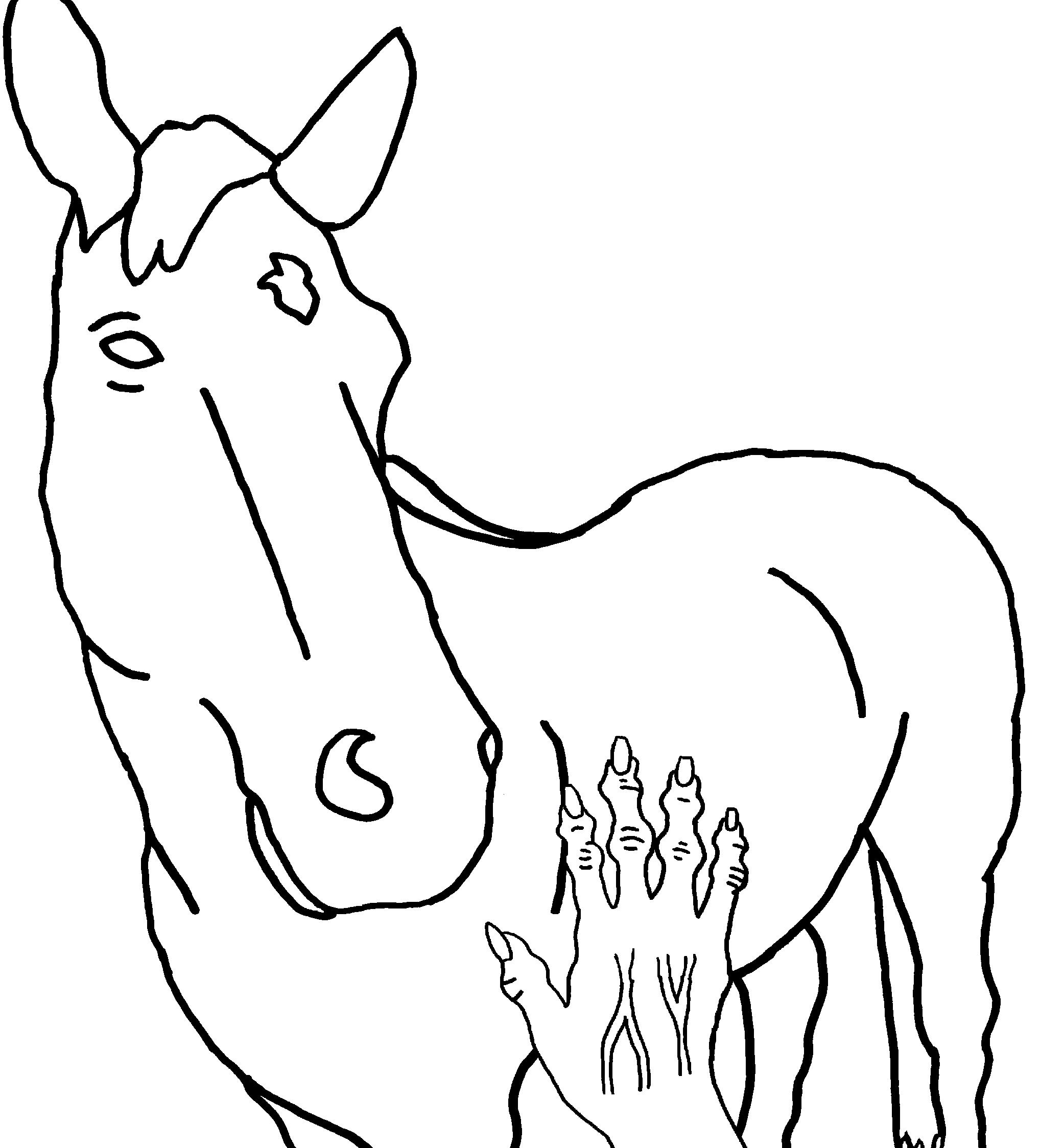
8. Simple coloring of image
Simplest coloring step, just using Microsoft Paint’s basic paint bucket. Tried to match colors to photograph. Tried making the hand green to begin with. The story did not specify the color and I wanted it to appear somewhat “other”.
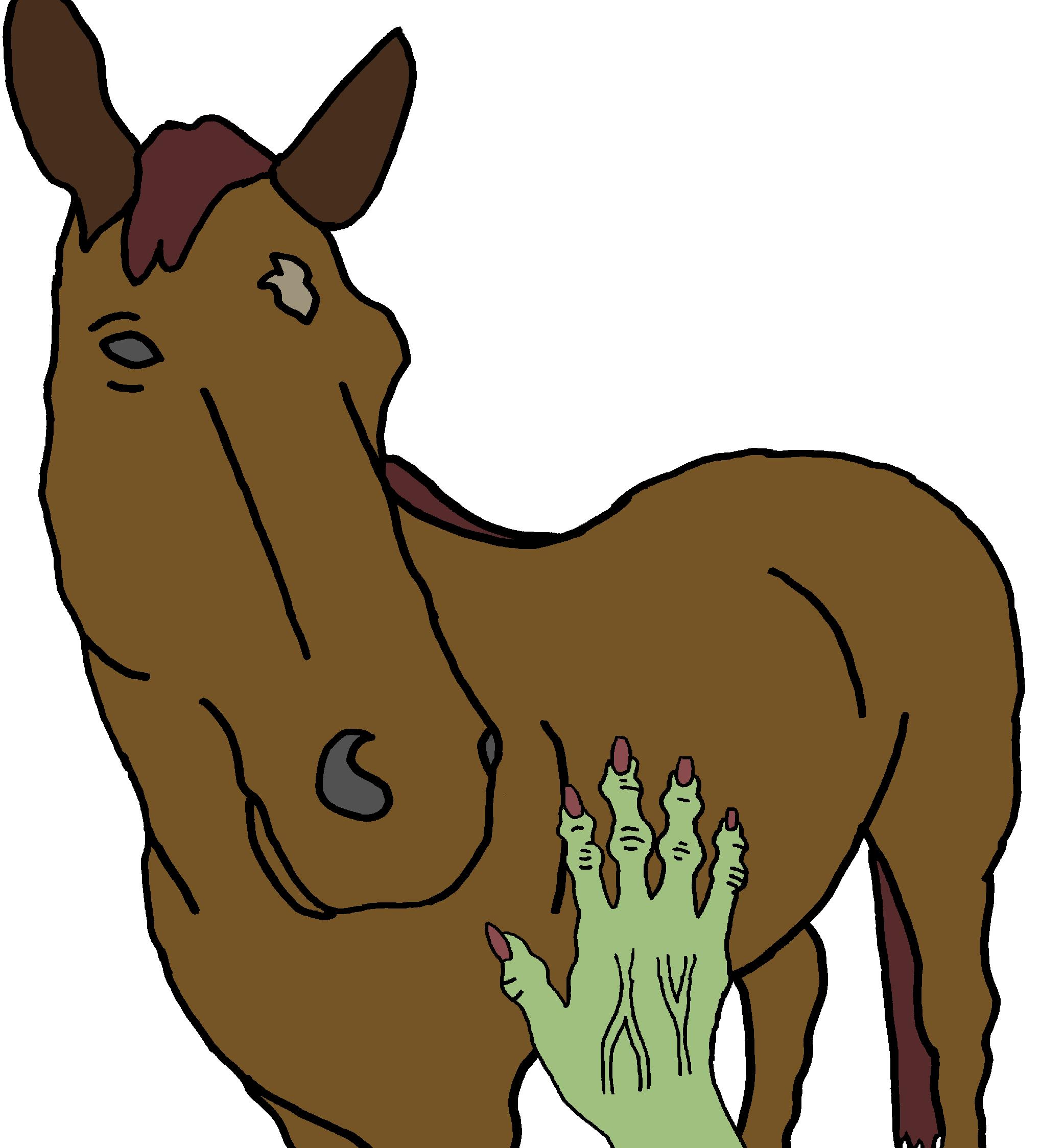
9. Color shading of image
That last coloring scheme was rather too simple, so tried to add a comic style 2 step shading to the main body of the horse as well as to the hand. To make the shaded areas look like a differently lighted patch of the same color, went into Microsoft Paint’s custom colors, started with the original color, and simply dialed the Saturation level down. Since the new shading levels suggest the shape of the horse’s body, I removed the black contour lines I’d added to suggest that shape.
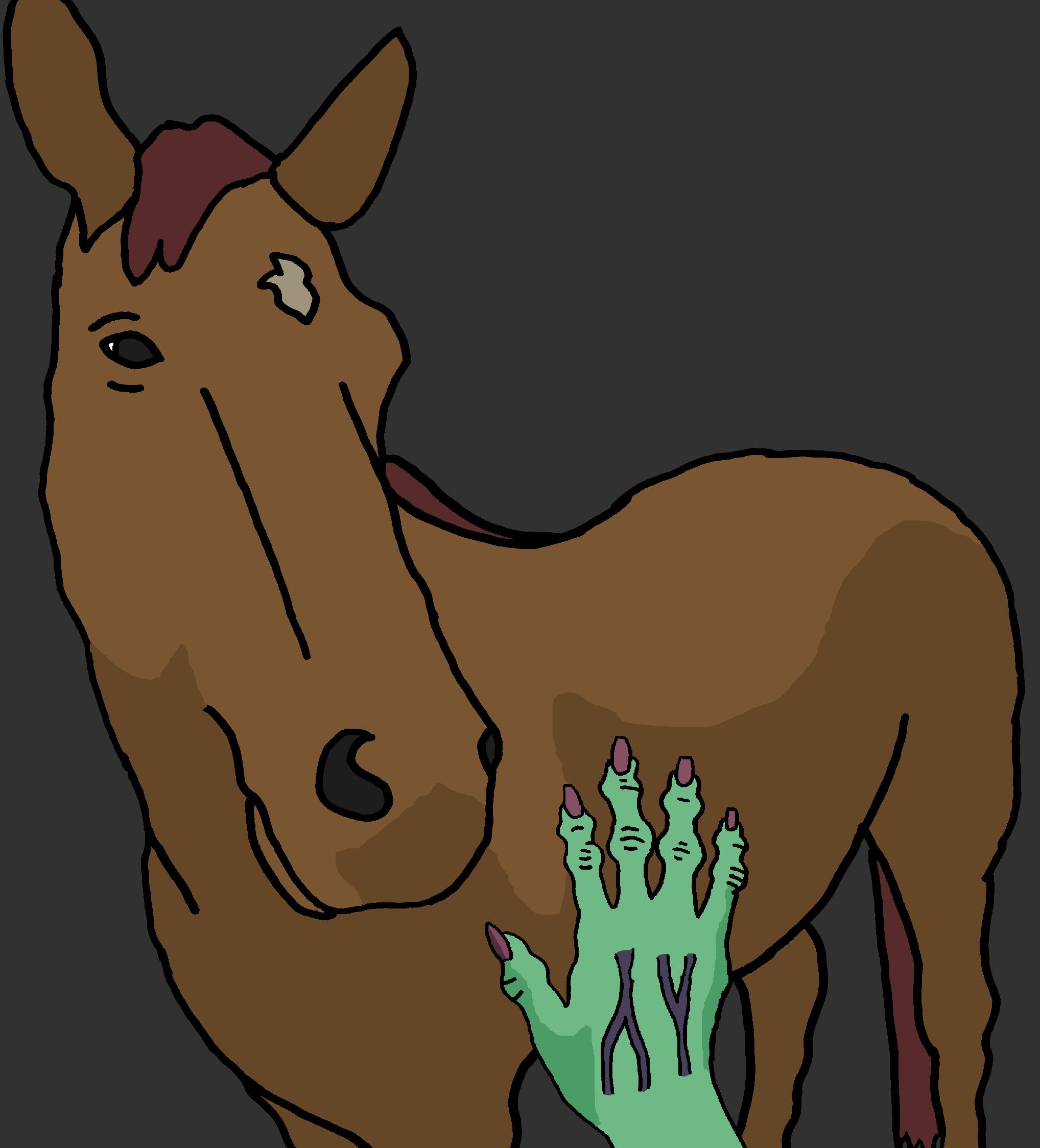
10. Extra Shading, Red Hand
I changed the color of the hand from green to shades of red because one person, upon seeing the image, immediately said “Is that a zombie and a donkey?” Okay, so green does tend to suggest zombies, so may as well change it. Confusing the horse for a donkey though… Not much to be done about that but educate him on the difference between donkeys and horses. 🙂
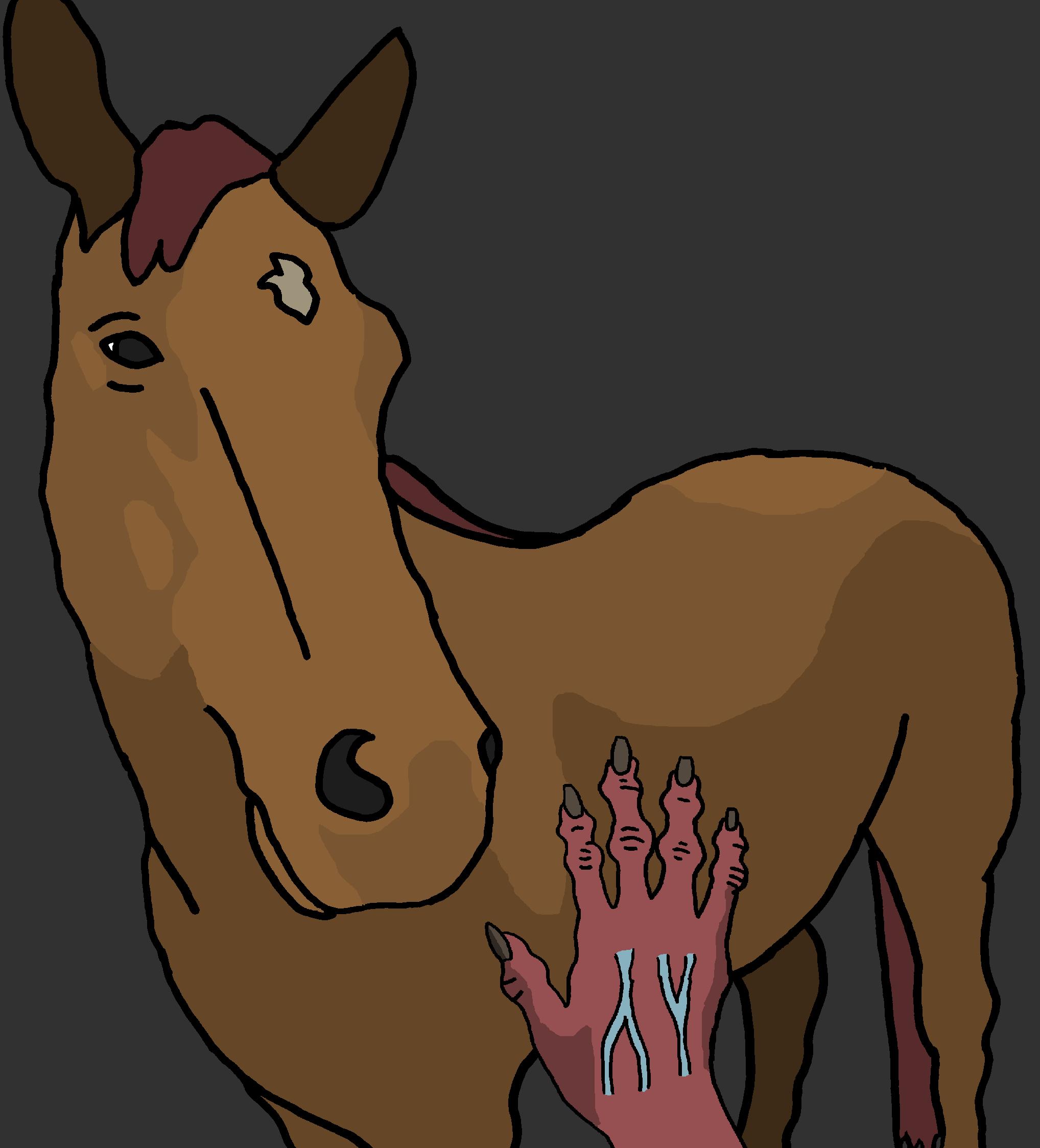
11. Final copy
Had to make some more changes before the final draft. In the original one, the hand is rather hidden behind the Drabblecast logo. There wasn’t anything to do but to shrink the image down and draw extensions. These extensions go outside the boundaries shown in the photo so I had to estimate what the rest would look like. I also added in a new background color with a gradient so it isn’t so uniform, and added in the title. I got some help from Bo on the title formatting, adding in the darker boundary to the letters, which i haven’t figured out how to do. That’s good because the font didn’t pop out of the background clearly enough without that.

“Marbles” by Ayn Sauer
“Marbles” is a dark story from a child’s point of view. This is one obsessive little girl, fixated upon her button collection. She plays by herself and sorts the buttons by size, color, number of holes. A neighborhood boy invites her over to play, and shows her his stuffed bunny with button eyes. Big mistake, as she immediately extracts one of the button eyes for her collection. And that’s not the end.
1. What to depict?
Decided to do this one in a child’s art style. I figured it could be a simple crayon drawing, perhaps a self-portrait drawn by the girl at a psychiatrist visit after the fact. And, what better moment to show, but the very moment when she has extracted the button eye. So I decided I’d draw the girl with the button, and the boy with the bunny within a child’s simple house shape. A bit later in the story, the boy’s cat plays an important role, so the cat’s in the image as well.
2. The drawing
I learned a lesson from the Malish illustration, to leave room at the bottom for the Drabblecast logo, so I made a grassy lawn down there. Simple house outline. Girl with triumphant smile and pose, holding up the button. Boy wailing and crying with one-eye bunny in tow. Cat off to the side. Instead of making an electronic font, I decided to draw the title and episode number into the crayon drawing itself. And, since the episode number has a zero in it, I made the zero into a button.
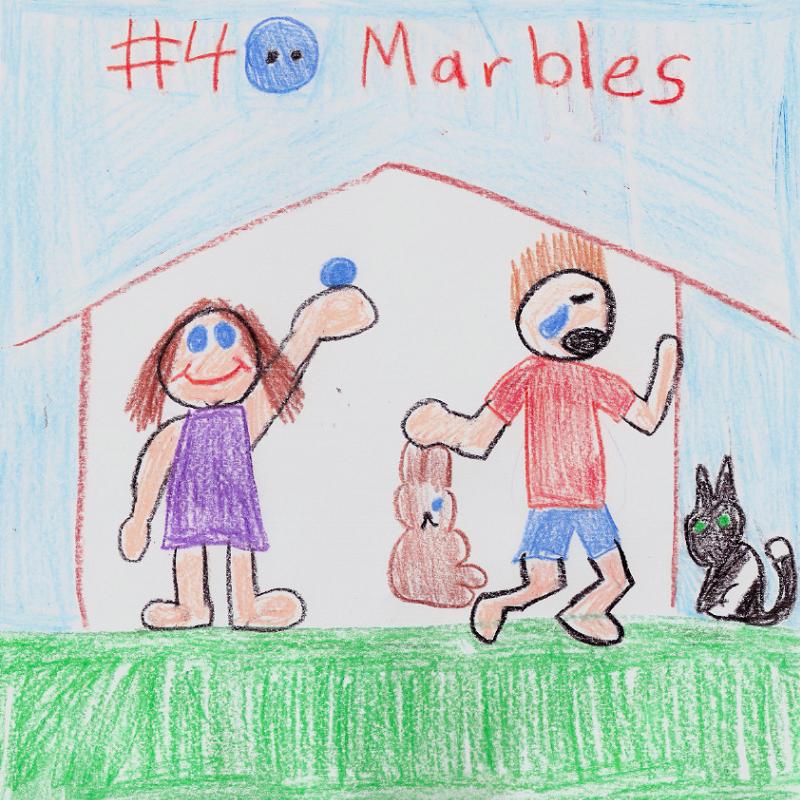
3. Final copy
I handed the image off to Bo, and he did some treatments to it, which I thought turned out well.
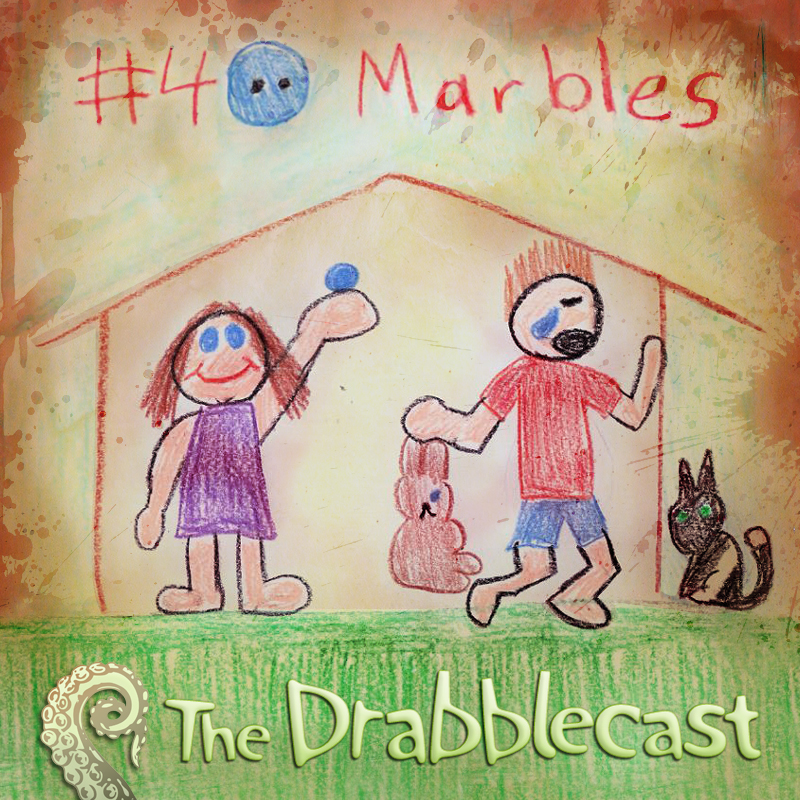
“The Fine Point” by Gary Cuba
“The Fine Point” has a very classic SF feel to it. In the story, someone has made a profound discovery about the world we live in–the world is made up of a limited set of repeating hexagon-shaped tiles. He proves this by marking a couple of nearby forested locations. Taking a photo from these two locations creates the exact same photograph. Evidence, he says, that rather than making every bit of Creation completely unique, God has used a repeating set of tiles.
I volunteered for this one because Gary’s a good friend of mine. I get a kick out of his stories and I thought it’d be fun to illustrate one of them to share with all the Drabblecast listeners.
1. What to depict?
This one was a bit trickier than the others to try to decide what to do. I wanted to get the speculative element into the illustration, but the speculative element in this case is extremely subtle. It manifests in the story by showing the two photographs side by side, but that by itself wouldn’t make a very compelling illustration to me. Instead, I decided that rather than illustrating an explicit scene/even in the story I would try to illustrate the concept of the story in a more abstract way. I decided that one way that I could manage to do this would be to try to do an image that might interest the great M.C. Escher, blurring the boundaries between reality and unreality. Since the pictures in the story were a forest, I thought I’d start with a forest.
2. Find a forest picture
I’d fully intended to take a forest picture with my own camera. But, that didn’t end up working out. Whenever I would head out to a nearby park, something would stop me from getting the picture. Sometimes it was weather. Once I got all the way there only to realize my camera batteries were too dead to take even a single picture. So, instead, I searched online and found at Burning Well, a website that has public domain images.
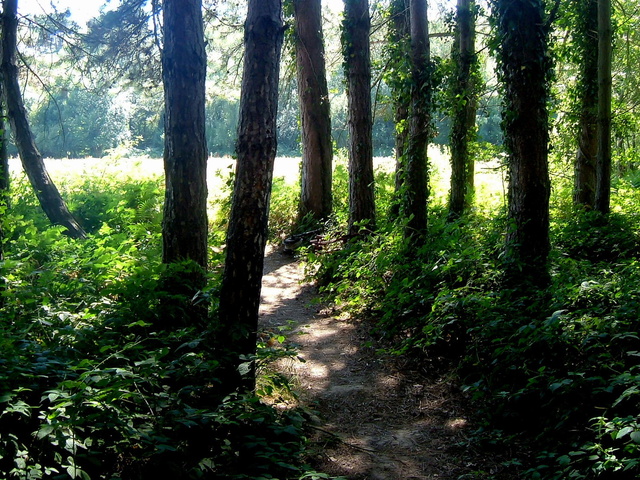
3. Sketch the forest
Hey, look, another use for tracing paper! :) I printed out the photo, then laid tracing paper over it. From that I was able to get the boldest outlines, the starkly contrasting tree trunks, the edge of the treeline in the background. There were a lot of details I had to doodle out by eyeballing it, all the leafy details especially.
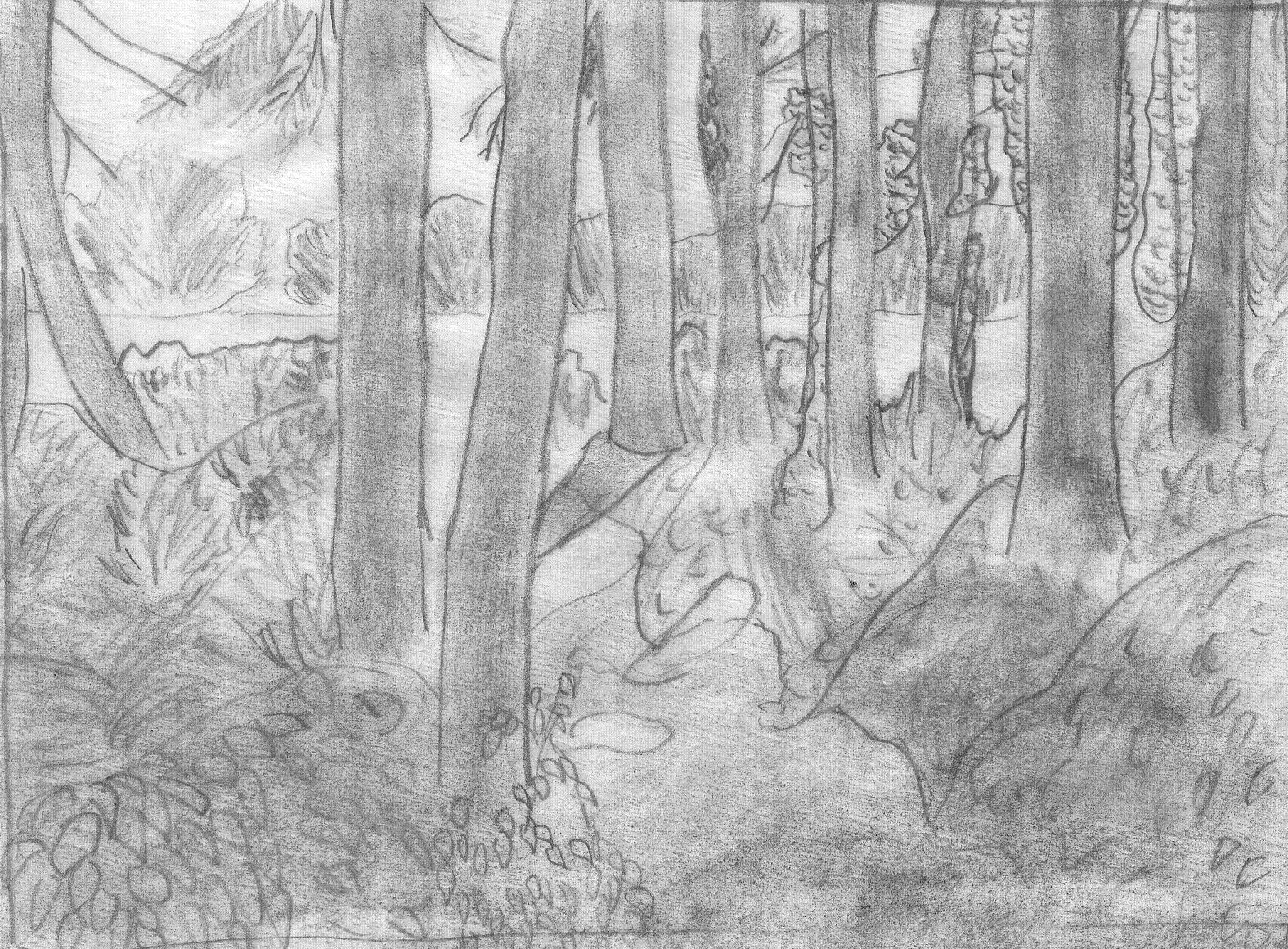
4. Lay out hexagon pattern
Just found a single hexagon and repeated the pattern until I’d filled the area. In GIMP, I made the spaces between the grid transparent. I wanted some hint of the hexagon tiles in the story, so that the illustration could more effectively bring the story to mind.

5. Combine, with layers
Okay, now to combine three layers together with selective transparency effects. Again, using GIMP.
First, the sketch on the bottom layer, no transparency.
![]() Next, the photograph on top of that, with a radial transparency to make it look like the photograph has bled away in a circular pattern.Â
Next, the photograph on top of that, with a radial transparency to make it look like the photograph has bled away in a circular pattern. 
![]() Next, the hexagon pattern. This one with a square transparency pattern, so that the hexagon just bleeds in at the very edge.
Next, the hexagon pattern. This one with a square transparency pattern, so that the hexagon just bleeds in at the very edge.
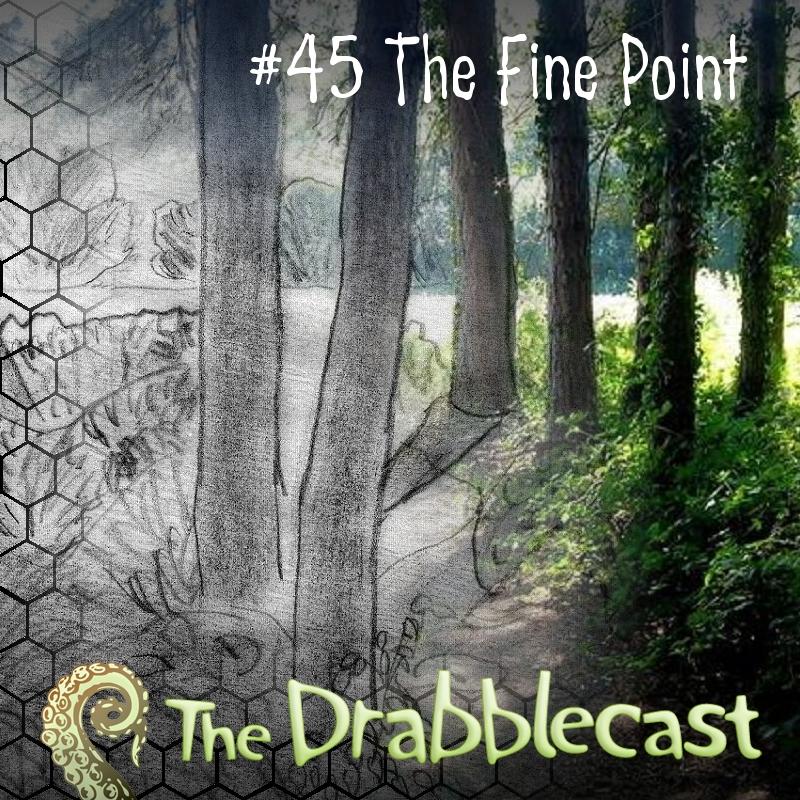
6. Final copy
I couldn’t quite figure out how to get the title just right, so I handed it off to Bo and asked him for help. He worked his magic, and made the title work very well with the image. Note that the new title even has a color gradient from gray to green, that matches the image. Perfect.
